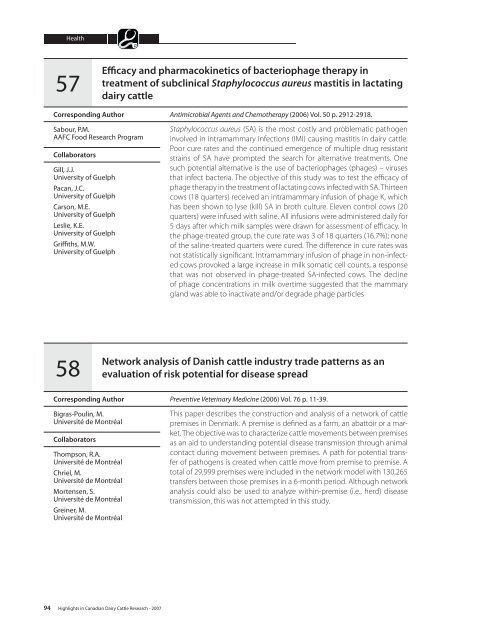Health57Efficacy and pharmacokinetics of bacteriophage therapy intreatment of subclinical Staphylococcus aureus mastitis in lactatingdairy cattleCorresponding AuthorSabour, P.M.AAFC Food Research ProgramCollaboratorsGill, J.J.University of GuelphPacan, J.C.University of GuelphCarson, M.E.University of GuelphLeslie, K.E.University of GuelphGriffiths, M.W.University of GuelphAntimicrobial Agents and Chemotherapy (2006) Vol. 50 p. 2912-2918.Staphylococcus aureus (SA) is the most costly and problematic pathogeninvolved in intramammary infections (IMI) causing mastitis in dairy cattle.Poor cure rates and the continued emergence of multiple drug resistantstrains of SA have prompted the search for alternative treatments. Onesuch potential alternative is the use of bacteriophages (phages) – virusesthat infect bacteria. The objective of this study was to test the efficacy ofphage therapy in the treatment of lactating cows infected with SA. Thirteencows (18 quarters) received an intramammary infusion of phage K, whichhas been shown to lyse (kill) SA in broth culture. Eleven control cows (20quarters) were infused with saline. All infusions were administered daily for5 days after which milk samples were drawn for assessment of efficacy. Inthe phage-treated group, the cure rate was 3 of 18 quarters (16.7%); noneof the saline-treated quarters were cured. The difference in cure rates wasnot statistically significant. Intramammary infusion of phage in non-infectedcows provoked a large increase in milk somatic cell counts, a responsethat was not observed in phage-treated SA-infected cows. The declineof phage concentrations in milk overtime suggested that the mammarygland was able to inactivate and/or degrade phage particles58Network analysis of Danish cattle industry trade patterns as anevaluation of risk potential for disease spreadCorresponding AuthorBigras-Poulin, M.Université de MontréalCollaboratorsThompson, R.A.Université de MontréalChriel, M.Université de MontréalMortensen, S.Université de MontréalGreiner, M.Université de MontréalPreventive Veterinary Medicine (2006) Vol. 76 p. 11-39.This paper describes the construction and analysis of a network of cattlepremises in Denmark. A premise is defined as a farm, an abattoir or a market.The objective was to characterize cattle movements between premisesas an aid to understanding potential disease transmission through animalcontact during movement between premises. A path for potential transferof pathogens is created when cattle move from premise to premise. Atotal of 29,999 premises were included in the network model with 130,265transfers between those premises in a 6-month period. Although networkanalysis could also be used to analyze within-premise (i.e., herd) diseasetransmission, this was not attempted in this study.94 Highlights in Canadian Dairy Cattle Research - 2007
Health59Formulation with CpG oligodeoxynucleotides increases cellularimmunity and protection induced by vaccination of calves withformalin-inactivated bovine respiratory syncytial virusCorresponding Authorvan Drunen Littel-van den Hurk, S.Vaccine and Infectious DiseaseOrganizationCollaboratorsMapletoft, J.W.Vaccine and Infectious DiseaseOrganizationOumouna, M.Vaccine and Infectious DiseaseOrganizationTownsend, H.G.Vaccine and Infectious DiseaseOrganizationGomis, S.University of SaskatchewanBabiuk, L.A.Vaccine and Infectious DiseaseOrganizationVirology (2006) Vol. 353 p. 316-323.Bovine respiratory syncytial virus (BRSV) is one of the four viruses known tobe associated with shipping fever in calves. Protection from BRSV has beenattempted with the use of a formalin-inactivated (FI) BRSV vaccine but withlittle success. In some cases, calves exposed to the virus after vaccinationwith FI-BRSV exhibit a more severe reaction than those who are not vaccinated.The failure of FI-BRSV vaccines to provide protection is thought tobe due to their inadequate induction of cell-mediated immunity. This studyexamines the potential to improve the cell-mediated immune response byformulating a FI-BRSV vaccine with a CpG oligodeoxynucleotide (ODN) – ashort DNA sequence previously shown to promote the release of mediators(cytokines) which stimulate cellular immunity. Newborn calves werevaccinated twice with FI-BRSV alone or with a formulation that includedCpG ODN and were subsequently challenged with BRSV. When comparedwith calves vaccinated with FI-BRSV alone, those immunized with FI-BRSV/CpG-ODN formulation demonstrated improved cell-mediated immune responsesas well as higher BRSV-specific serum antibody (IgG2) levels. Theamount of BRSV in lung tissue also decreased in calves that received theFI-BRSV/CpG-ODN formulation.60Monensin might protect Ontario, Canada cows fromparatuberculosis milk-ELISA positivityCorresponding AuthorHendrick, S.H.University of GuelphCollaboratorsDuffield, T.F.University of GuelphLeslie, K.E.University of GuelphLissemore, K.D.University of GuelphArchambault, M.Université de MontréalBagg, R.ElancoDick, P.ElancoKelton, D.F.University of GuelphPreventive Veterinary Medicine (2006) Vol. 76 p. 237-248.Johne’s Disease (JD) is a production limiting disease of ruminants causedby Mycobacterium avium subspecies paratuberculosis (MAP). In infecteddairy herds, JD results in reduced milk production and premature cullingof lactating cows. In a clinical trial with naturally MAP-infected cattle, theseverity of gastrointestinal lesions caused by MAP was reduced by feedingmonensin, a polyether ionophore that inhibits bacterial replication bymodifying the permeability of the cell membrane. Fewer lesions and reducedfecal shedding of MAP were also observed in a study where monensinwas fed to young calves. Dairy cattle diets are routinely supplementedwith monensin. It is fed in calf starters to control coccidiosis, in heifersupplements to increase feed efficiency and in lactation diets to minimizeketosis. Farm managers may use monensin in all, none or any combinationof these diets and practices may vary depending on the JD status of theherd. The objective of this study was to evaluate associations of these andother management practices with herd JD-status assessment using a milkenzyme-linked immunosorbent assay (ELISA). Milk samples from 4,933dairy cows in 94 Ontario dairy herds were tested. In 48 herds where JD hadnot previously been diagnosed, cows were less likely to be found ELISApositiveif calf hutches were used and cows received monensin, either as apremix or controlled release capsule (CRC). Feeding monensin to breedingage heifers reduced the likelihood that cows would be ELISA-positive inthe 46 herds in which JD had previously been diagnosed.Health 95





